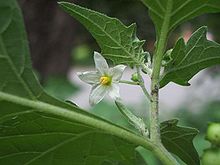| Solanum nigrum | |
|---|---|

| |
| Scientific classification | |
| Kingdom: | Plantae |
| Clade: | Tracheophytes |
| Clade: | Angiosperms |
| Clade: | Eudicots |
| Clade: | Asterids |
| Order: | Solanales |
| Family: | Solanaceae |
| Genus: | Solanum |
| Species: | S. nigrum
|
| Binomial name | |
| Solanum nigrum | |
| Subspecies | |
|
S. nigrum subsp. nigrum | |

Solanum nigrum, the European black nightshade or simply black nightshade or blackberry nightshade,[1] is a species of flowering plant in the family Solanaceae, native to Eurasia and introduced in the Americas, Australasia, and South Africa. Ripe berries and cooked leaves of edible strains are used as food in some locales, and plant parts are used as a traditional medicine. Some other species may also be referred to as "black nightshade".[2]
Solanum nigrum has been recorded from deposits of the Paleolithic and Mesolithic era of ancient Britain and it is suggested by the botanist and ecologist Edward Salisbury that it was part of the native flora there before Neolithic agriculture emerged.[3] The species was mentioned by Pliny the Elder in the first century AD and by the great herbalists, including Dioscorides.[4] In 1753, Carl Linnaeus described six varieties of Solanum nigrum in Species Plantarum.[5]
- ^ Grubb, Adam; Raser-Rowland, Annie (2012). The Weed Forager's Handbook. Australia: Hyland House Publishing Pty Ltd. p. 35. ISBN 9781864471212.
- ^ Mohy-ud-dint, A; Khan, Z; Ahmad, M; Kashmiri, MA (2010). "Chemotaxonomic value of alkaloids in Solanum nigrum complex" (PDF). Pakistan Journal of Botany. 42 (1): 653–660.
- ^ Salisbury, EJ (1961). Weeds and Aliens. New Naturalists Series. London: Collins.
- ^ Edmonds, JM; Chewya, JA (1997). Black Nightshades, Solanum nigrum L. and related species. International Plant Genetic Resources Institute. ISBN 9789290433217.
- ^ Linnaeus, C (1753). Species Plantarum IV-V.